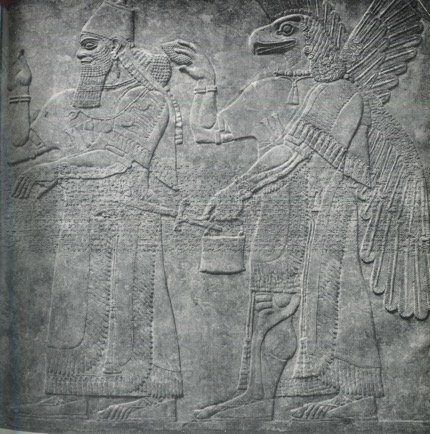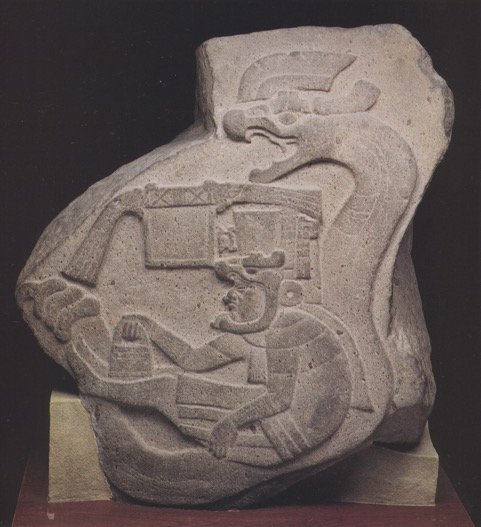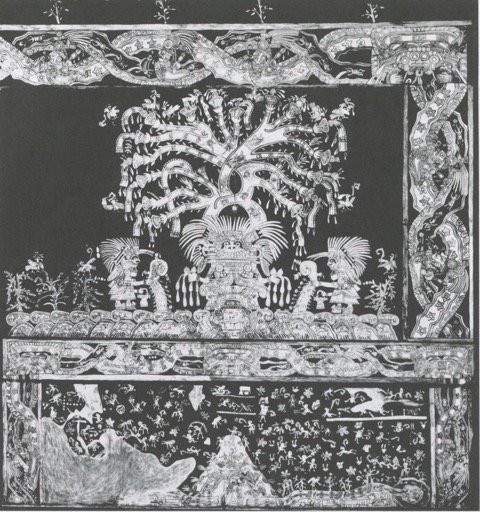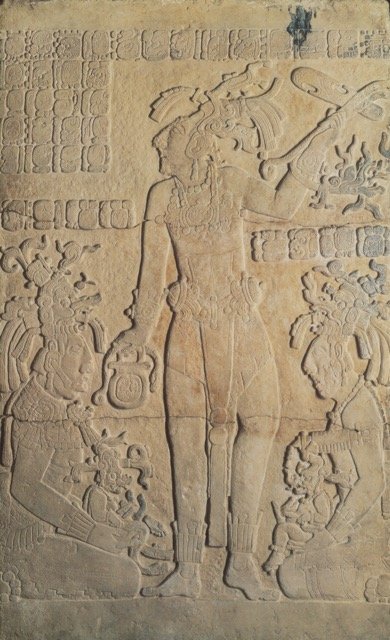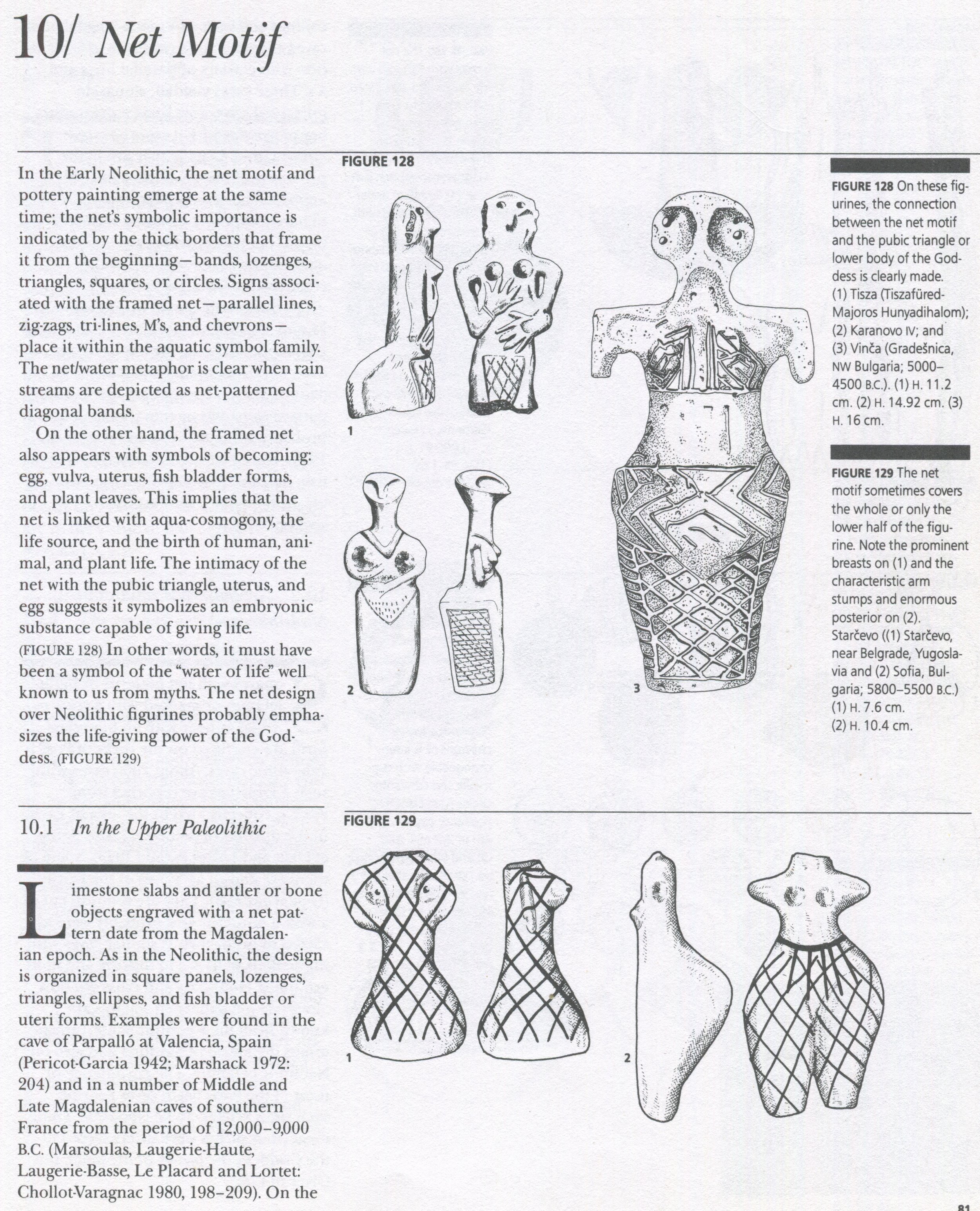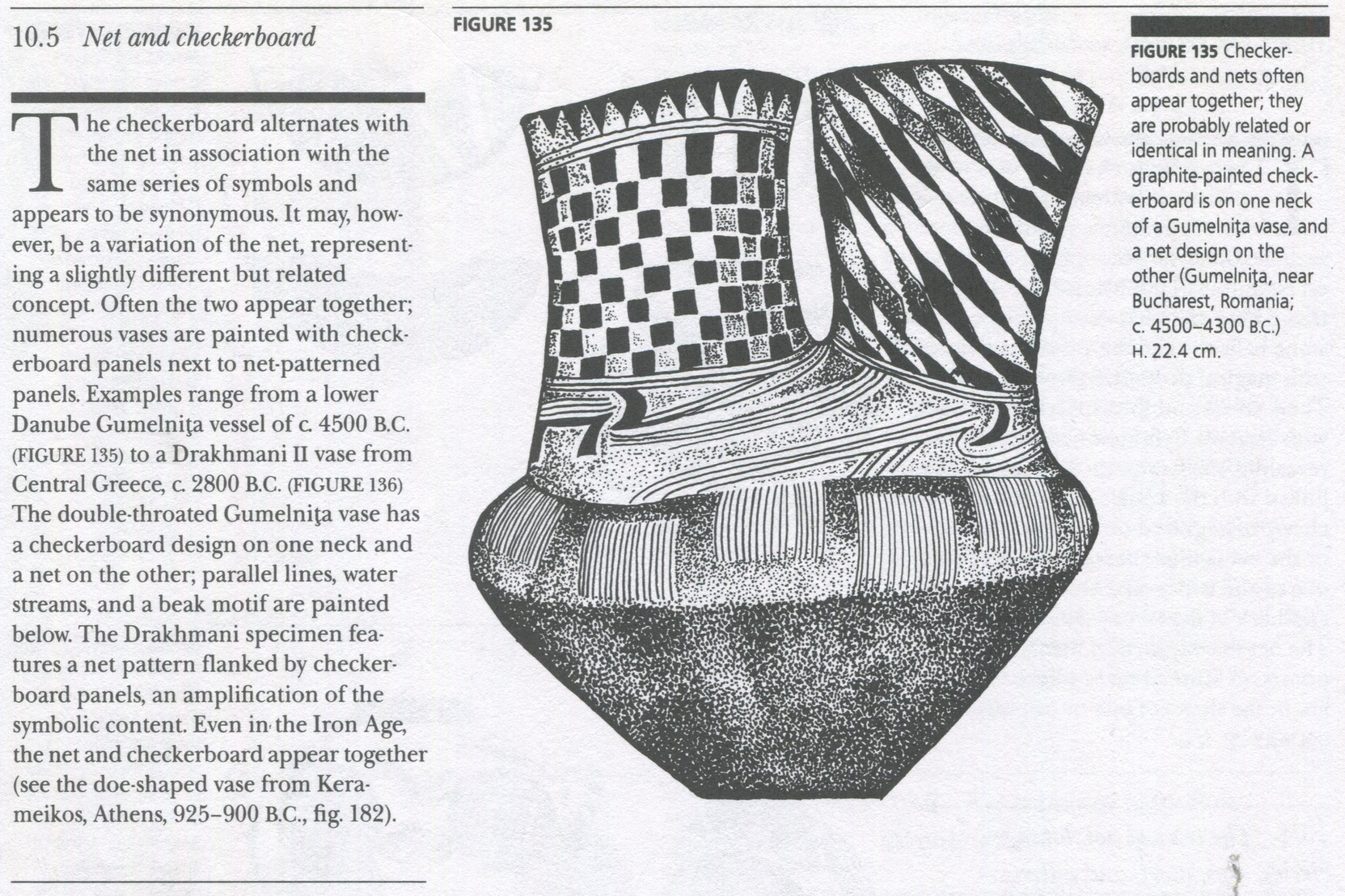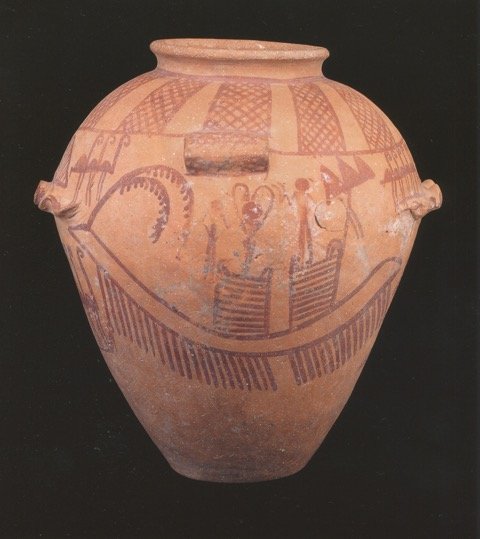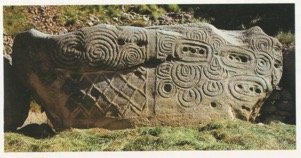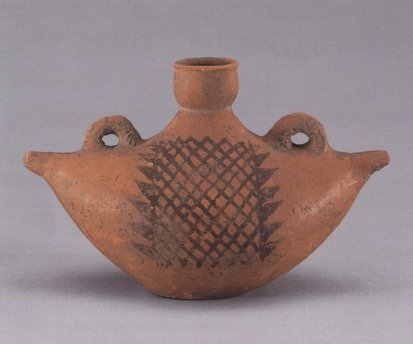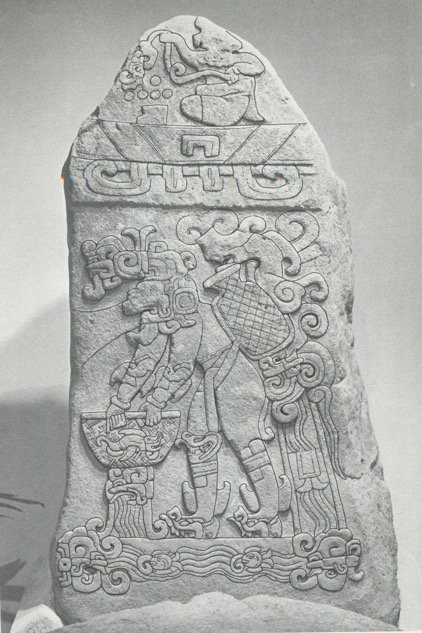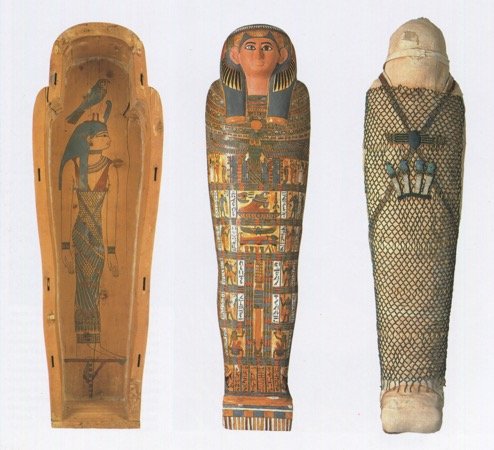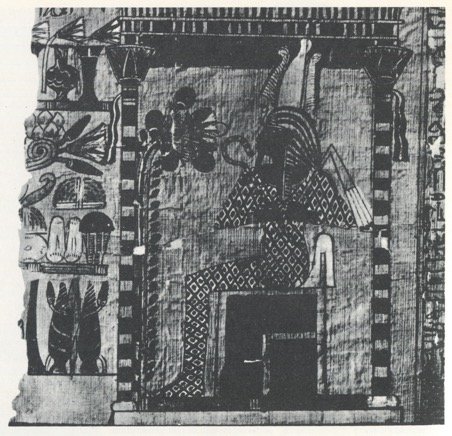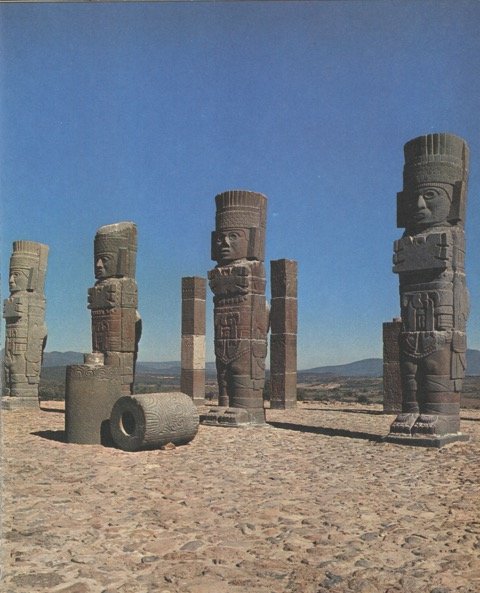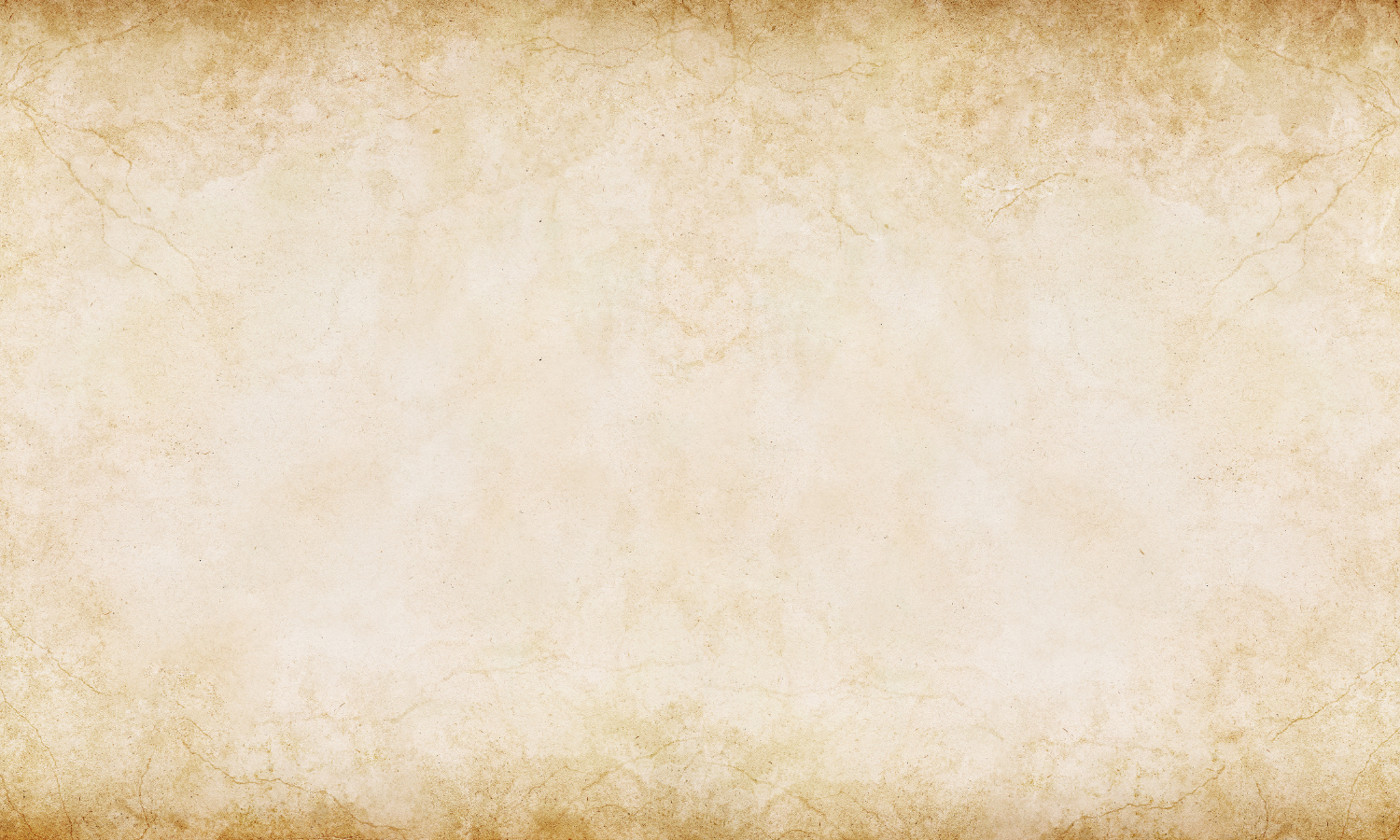
ART MOTIFS
Figures 1-21
THE ASSYRIAN BUCKET
This art motif, often labeled a ‘bucket’ by art historians, is quite the anomaly. First appearing as early as the 10th century BCE at Gobekli Tepe then disappearing from the historical record only to reappear nine millennia later nearly simultaneously in Assyria and in Mesoamerica. This motif with the round handle and square bottom section occurs only in these three places that I know of. Interesting to note the similarity of the round handle of the Olmec bucket with those seen on the Vulture Stone at Gobekli Tepe as compared to the handle of the Assyrian bucket.

Fig. 2 The Vulture Stone ca.10th century BCE Gobekli Tepe, Anatolia
Fig. 3 Assyrian Wall Panel ca. 900 BCE Mesopotamia
Fig. 2 The Vulture Stone ca.10th century BCE Gobekli Tepe, Anatolia
This T shaped pillar may be the earliest known example of the knowledge of celestial mechanics and the Vernal Equinox being encoded in stone. Both the T shape and Christ’s crucifixion likely share the same equinox scenario, discussed in more detail below. (Fig.96) The number and location of the three buckets at the very top suggest the locations on the horizon of the rising and setting sun on the equinoxes and solstices. There are three birds of different sizes, all with a distinctive dot for an eye with the bird at the bottom of the vertical shaft displaying the circumpunct, a circle with a dot in the center, a motif that suggests either earth’s orbit around the sun or more likely the relationship between the pole star and earth’s rotation. The neck and jaw are in the ‘hook’ shape implying earth’s axial tilt discussed below. An almost identical bird-hook-jaw motif can be seen in the Bison Hunt cave art at Lascaux. (Fig.144) The larger of the two birds on the upper horizontal section with three nearly concentric rings around its neck is shown almost balancing a sphere on its wing with feathers displayed sloping down from left to right in the celestial equator angle suggesting earth’s rotation. The bald head of this bird is similar to the bird with a circumpunct eye seen on the Mayan Buenavista vase painted approximately 10,000 years later. (Fig.142) The bird at the bottom faces to the left, possibly towards the west with the two birds at the top facing in the opposite direction, possibly towards the eastern horizon on the Vernal Equinox. The scorpion with one of its two pincers just touching where the lower vertical shaft and the upper horizontal section meet suggests both earth’s rotation and the tilted polar axis that hooks, pinches, or fixes in time the locations on the horizon where the sun rises and sets. The scorpion’s movement across the earth’s surface may also seem to mimic the serpent-like path of the sun as it passes over the earth’s surface with one of the scorpion’s left legs touching the top of the bird’s head completing the connection between earth’s rotation and its axial tilt.
Fig. 3 Assyrian Wall Panel ca. 900 BCE Mesopotamia
The bucket motif shown on this Assyrian palace wall panel is a cultural tool kit of sorts containing the arts of civilization, the accumulated and refined knowledge of the Neolithic. This body of knowledge very likely not only included knowledge of earth’s celestial mechanics along with a certain amount of sophisticated mathematics but possibly also knowledge of the Precession of the Equinoxes, something that would require extensive record keeping over millennia. Each constellation in the 25,920 year cycle takes about 2,160 years and given the nine millennia of watching the night skies since the Vulture Stone at Gobekli Tepe was carved, several constellations would have come and gone setting on the eastern horizon at dawn on the Vernal Equinox. The round handle symbolizes the sky ‘above’, which is ‘time’, and the square bottom section represents ‘space’, the earth ‘below’. Note the scabbard like motif protruding from the king’s side. The ‘thumb’ of the left hand of the gryphon holding the bucket’s handle is touching the scabbard as it passes behind the bucket’s handle. This motif is slanted at an angle that suggests the celestial equator with the short vertical section at a right angle to it symbolizing the tilted polar axis. The king with the scabbard presumably containing a sword along with the bucket held by a feathered gryphon seem to suggest a connection between the knowledge of celestial mechanics and the right to rule.

Fig. 4 Monument 19 c. 900 BCE La Venta Olmec
Fig. 5 Tepantitla Mural ca. 150 Teotihuacan
Fig. 4 Monument 19 c. 900 BCE La Venta Olmec
The figure on this Olmec monument from La Venta is shown facing to the left, possibly west, carrying a round handle square-bottomed bucket in his right hand and reaching down to suggestively ‘hold’ a horizontal motif while just touching with his left hand the feathered serpent upon which he is ‘riding’. This bucket motif directly links the Feathered Serpent to the Old World and provides some of the most compelling evidence for diffusion. The Feathered Serpent shown here in association with the Gobekli Tepe style bucket also seems imported, but not from Mesopotamia. (Fig.129) The figure’s ear-spool, spherical back, and three concentric rings around his neck and shoulders all suggest the symbolic encoding of earth’s celestial mechanics with the Vernal Equinox also being possibly encoded by the stylized headdress the figure wears. The square shape represents either the earth’s celestial equator or the plane of the ecliptic, possibly both as they interact on the equinox, with the horizontal element across the top held at opposite ends in the mouths of two feathered serpents symbolizing the horizon. The feathers of the feathered serpent at the left are shown in the symbolic axial tilt angle with the feathers of the other displayed not quite perfectly horizontal, suggesting rotation, or the plane of the ecliptic, possibly both at an equinox dawn. Though very difficult to see, the ‘x’ motifs are very likely the kin-cross glyph motif and its twin, (Fig.43) with the crossed bands displaying the preference of one band overlapping the other symbolizing either earth’s celestial equator or its axial tilt. Along with the angle of the feathers and the central element separating the x’s, which in all likelihood symbolize the solstices, together suggest the symbolic encoding of the of earth’s celestial mechanics at dawn on the Vernal Equinox.
Fig. 5 Tepantitla Mural ca. 150 CE Teotihuacan
Two figures approaching a central deity from the left and the right carry round handled objects in their left hands and the ‘hook and wing’ motif in their right hands that also seem to touch a water or rain symbol. The deity in the center of the image has an elaborate floral headdress and hands that also seem to be dripping with ‘rain’. The objects they carry very likely symbolize all or most of what is contained in the La Venta bucket with a local, cultural variant shape for the bottom section. The equinox is also very likely encoded in the border to the right and across the top. Along the border at the right are two figures intertwined in serpent like motifs, one with a concentric eye, the other with a concentric ear spool moving vertically to meet a single figure in the corner with concentric eyes and ear spools. ‘Three’ figures emerge from the corner moving to the left, or west horizontally across the top further entwined in the same serpent motifs with the light and dark colored serpent likely representing earth’s day and night rotation with the stars on the other serpent symbolizing the heavens and earth’s axial tilt. Two of these figures are shown with concentric ear spools and the third serpent-like entity has both a concentric eye and an ear spool possibly symbolizing the pole star on the equinox. The equinox scenario begins with earth’s tilted celestial equator, the Feathered Serpent, represented by the two figures at the right seen approaching their rendezvous with the plane of the ecliptic on the Vernal Equinox. The entity in the ‘corner’, Sovereign, represents the plane of the ecliptic with the three entities that emerge at dawn on the equinox symbolically representing earth’s celestial mechanics, its orbital angular momentum in relation to the plane of the ecliptic, and the relationship between earth’s tilted axis and the pole star, Heart of Sky.

Fig. 6 Palenque Wall Panel ca. 700 CE
Fig. 7 Stela 1 Hieroglyphs Copan
Fig.6 Palenque Wall Panel ca. 700 CE
This wall panel from Palenque shows K’inich K’an Joy Chitam holding a serpent and a round handled object with the akbal night glyph in his right hand and an atlatl type device in his left hand. The night glyph suggests earth’s rotation and the serpent its tilted polar axis. The raised left foot may be symbolically encoding the angle of earth’s axial tilt that slants down from right to left. The atlatl is composed of two objects. The hook bottomed handle held at this angle symbolizes earth’s axial tilt with the other object symbolizing earth’s rotating celestial equator. There are also concentric motifs on each of his wrists that suggest earth’s celestial mechanics and possibly the marking, or ‘hacking’ of time of a particular event. The akbal night glyph shown on the ‘round bottomed-round handled’ object that K’an Joy Chitam holds very likely represents night just before dawn on the Vernal Equinox. His lifting of his left foot and raising the atlatl in his left hand while holding the bucket like motif with the night glyph and a serpent in his right hand seem to suggest his dancing, possibly in trance, to earth’s rhythms as it aligns with the plane of the ecliptic while rotating into the Vernal Equinox dawn. (See Portal Grid/Maya Vase K2772)
Fig. 7 Stela 1 Hieroglyphs Copan
The hieroglyph at the top of Stela I at Copan appears to be a Classic Maya variation of the La Venta round handle bucket motif. This bucket has an elliptical body with an elliptical handle and a flat bottom. The two vertical cross hatch rectangles separated by an open space are sitting on the horizon and most probably represent the measuring of time between either solstice and an equinox.

Fig. 8 Olmec Bucket
THE DIAMOND NET
The Diamond Net motif is one of the oldest and most widespread art motifs in the world. Appearing in the Old World as early as the 5th century BCE in Eastern Europe. This motif, and the closely related ‘crosshatching’ technique both were very likely sourced from the same equilateral triangle geometry found in the circle, though seem to have slightly different but closely related meanings down through time. From birth to death, fertility and the afterlife, amniotic fluids to the final crossing, water is central to most world mythologies. Life, death, immortality, and rain all fall within the earth god’s tilted axis domain, in other words, celestial mechanics. The diamond net found in combination with a checkerboard motif, refers to either celestial mechanics, and or the mathematics used in measuring time and space, as above, so below. A variation of the diamond net involves squares projected vertically in a similar net pattern. This vertical square motif suggests a combination of the earth’s dual personality, its rotation and its tilted axis, the feathered serpent, as discussed below beginning with the Mat Symbol (Fig.26). On the Maya carving shown, a diamond skirt is seen in association with the ‘mat’ symbol a bar that slants down from right to left, the earth’s axis, the Mayan kin-cross glyph. The other bar of the square that slants down from left to right mimics the earth’s celestial equator. These vertical motifs slanting in a particular direction most likely refer to a particular interpretation of celestial mechanics artistically encoded in myth. This appears to be something of a global phenomena.

Fig. 9 Net Motif c. 6th century BCE Old Europe
Fig. 10 Net and checkerboard c. 5th century BCE Old Europe
Fig. 9 Net Motif c. 6th century BCE Old Europe
Fig. 10 Net and checkerboard c. 5th century BCE Old Europe
The diamond net motif on this vase, depicted in association with the checkerboard motif, possibly refers to water and the life giving properties of earth’s celestial mechanics as something, ‘as above, so below’ and or the ‘sky and earth’ of the bucket motif, both likely symbolizing a certain mathematics associated with earth’s celestial mechanics and the seasons. As a net motif the square sections, especially compared to the slanted diamond net, very likely represent the earth’s surface or the plane of the ecliptic, probably both. The checkerboard motif is found not only in ancient Egypt but is also is found at both Palenque (Fig.77) and Kohunlich. (Fig.76)

Fig. 11 Naqada Vase c. 4000 BCE Egypt
Fig. 12 Newgrange c. 3200 BCE Ireland
Fig. 11 Naqada Vase c. 4000 BCE Egypt
Cross hatch rectangular shapes, regularly spaced and resting on a line that encircles the neck, suggesting the horizon, and birds with ‘hook’ necks at either end of a boat with three figures, two of which stand on throne like structures with nine divisions that face to the west. All together these motifs suggest mythologized celestial mechanics, with the boat, a likely forerunner to the boats found in the Egyptian Book of The Dead, encoding the earth orbiting the sun as a boat on a river.
Fig. 12 Newgrange c. 3200 BCE Ireland
Newgrange, located on the River Boyne in Ireland where this artifact is found, is a shaft grave aligned to the rising sun on the Winter Solstice, the shortest day of the year. The net pattern is very close to the diamond shaped net and being associated with the ‘spiral hook’ motifs just above together with the Winter Solstice alignment seem to suggest the knowledge of celestial mechanics being ritually encoded on the last dawn of the old sun.
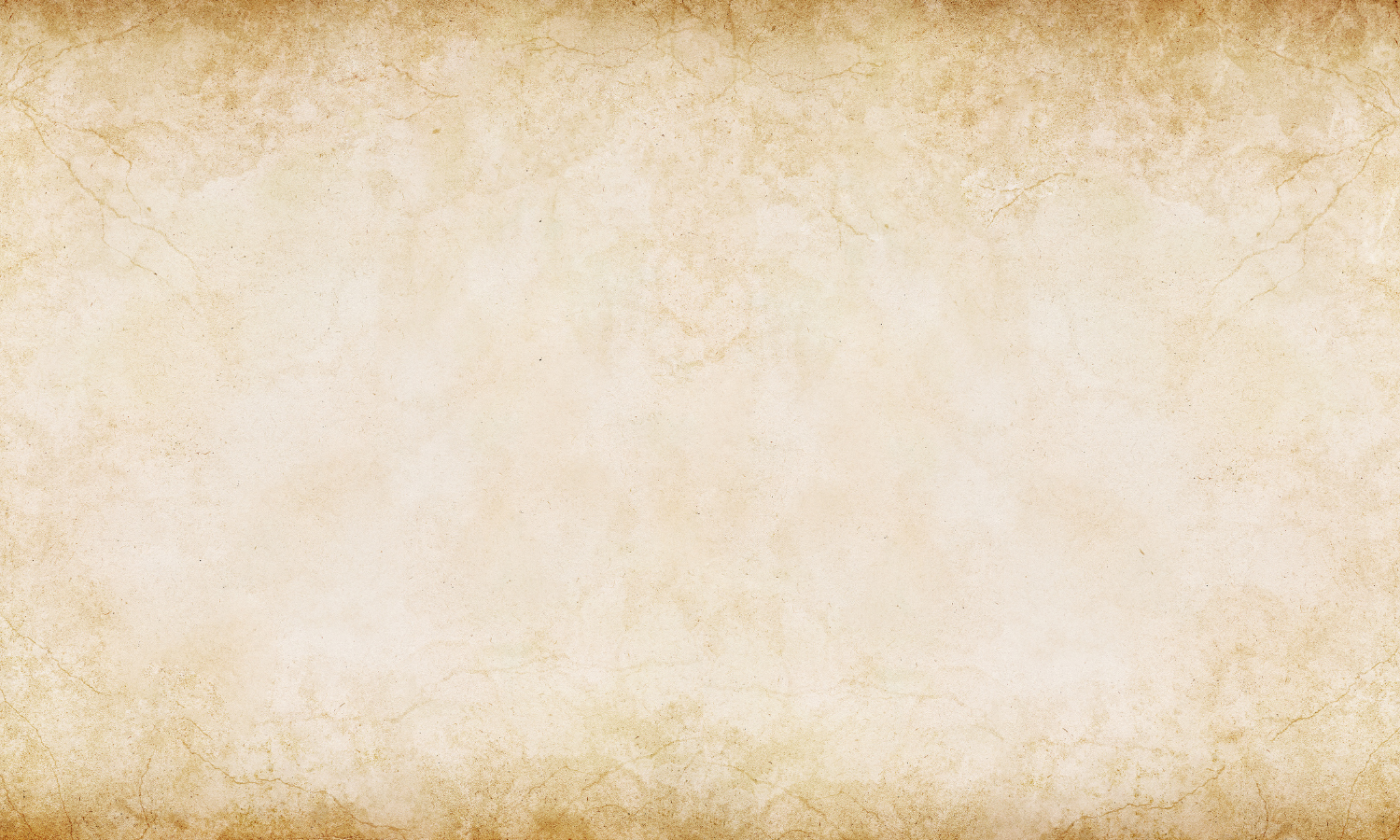
Fig. 13 Chinese Ceramic c. 4500-4000 Xian, China
Fig. 14 Chinese Ceramic c. 3000-2500 BC China
Fig. 13 Chinese Ceramic c. 4500-4000 BCE Xian, China
This net motif, similar to the cross hatching on the Naqada vase, is not exactly the diamond net, but somewhat similar to the vertical square net motif. Either way, depicted in this setting on a water carrier links the motif to water.
Fig. 14 Chinese Ceramic c. 3000-2500 BCE China
The crosshatched object depicted on the bottom of this bowl seems to also link this motif with water. This round crosshatched object is suspended inside of a creature with an oval body suggesting earth’s orbit around the sun. The cross hatching is a little more diamond net like, but not much. The three lines down the center of the circular ‘net’ separating the two ‘hemispheres’ do not align with what appears to be the head of this creature, possibly suggesting the earth’s rotation on its tilted polar axis. By filling this bowl with water and floating a piece of magnetized iron on a piece of wood, then aligning the floating ‘needle’ at a right angle to the centerline at the bottom of the bowl while pointing the bowl towards the east, true east and the location on the horizon of the rising sun on the Vernal equinox could be determined. Was this bowl an equinox ritual timing device or possibly some type of compass used for navigation or mapping?

Fig. 15 Olmec Cup c. 1200 BCE
Fig. 16 Izapa Stela c. 150 BCE-150 CE
Fig. 15 Olmec Cup c.1200 BCE
This creature with the ‘Olmec Eye’ very likely encodes the core of the feathered serpent cosmology, the Vernal Equinox, and an understanding of the celestial mechanics involved. The eye in the ellipse in association with the net motif suggests a common origin, the circle’s geometry. The vertical and horizontal net motif the eye interacts with is nearly three-dimensional. It has three dashed vertical lines and two distinct borders the end, or apex, of the elliptical ‘eye’ touches. In this scenario, the outer border probably represents the earth’s orbit around the sun with the inner boarder representing the earth’s surface or its rotation. The ‘mouth’ or upper jaw, is composed of a vertically slanting diamond net motif, tilted at the down, left to right, celestial equator angle, that merges with a more horizontal rectangular net motif with vertical elements slanted at the axial tilt angle that likely represent the earth’s tilted axis altogether encoding some version of the earth’s celestial equator and tilted axis intersecting the plane of the ecliptic at dawn on the Vernal equinox.
Fig. 16 Izapa Stela c. 150 BCE-150 CE
The diamond net motif is here again associated with water, this time depicting the hydrologic cycle and the earth deity responsible for the seasons shown holding a hemisphere full of water and a fish while gripping with both hands what is very likely earth’s celestial equator. The ‘hook motif’ prominently displayed throughout the cycle, especially surrounding the netted water container, implies the role the axial tilt plays in bringing the rainy season to Izapa.

Fig. 17 Sarcophagus c. 700 BCE 25th Dynasty Western Thebes Eqypt
Fig. 18 Osiris Egypt
Fig. 17 Sarcophagus c. 700 BCE 25th Dynasty Western Thebes Egypt
The diamond net motif is here associated with death, sometimes thought of as crossing a river, a body of water, or heavenly space. The crossed ‘X’ on the chest appears to represent where the two 60/60/60 equilateral triangles found in the circle’s geometry meet. Where they cross can be thought of as the axis of the planet. The axis of the planet, being the diameter of a sphere can also be associated with the Square Root of Three, which is also the diagonal of the three dimensional ‘cube’. The long sides of the rectangle where the two equilateral triangles are found are multiples of the Square Root of Three. (See Portal Grid. Pt.1) All of this together points to a belief that the direction north, the Pole Star, and the Precession of the Equinoxes and the celestial mechanics involved as being some sort of portal in time or space, probably both. The four Horus’s just below very likely represent earth’s axial tilt and the four seasons, or stations of the earth’s annual orbit around the sun, the two solstices and the two equinoxes.
Fig. 18 Osiris Egypt
Osiris, facing east, possibly at dawn on the Vernal Equinox, is wearing the diamond net motif and holding the crook in his left hand and flail in his right. The crook and the angle at which it is held represent the earth’s axial tilt. The flail and the angle at which it is held represent earth’s rotation. The three feathers represent the solstices and the equinoxes. The atef crown he wears is composed of two feathered hooks, feathers of truth, flail and crook, feather and serpent, equinox and solstice.

Fig. 19 Osiris Eqypt
Fig. 20 Pacal’s Sarcophagus Cover c. 675 CE Palenque
Fig. 19 Osiris Egypt
Osiris, facing west, possibly towards the setting sun on, is wearing the diamond net motif and holding the crook in his right hand and the flail in his right. The crook being held at the rotation angle has something to do with a narrative focused on the axial tilt. The flail held at the angle of the axial tilt not only suggests the complimentary nature of the earth’s rotation and its tilted axis but also the role the axis plays in determining where on the horizon the sun sets, possibly at the end of the Vernal Equinox day.
Fig. 20 Pacal’s Sarcophagus Lid c. 675 CE Palenque
As Pacal ascends he is seen wearing a diamond net beaded skirt with a ‘cube’ that is missing the uppermost chord. The diamond net motif and the cube are sourced directly from the same geometry found in the circle and both are here associated with death and or the after life and very likely the Square Root of Three as well. For a more detailed description see Fig.113.

Fig. 21 Toltec Statues c. 1000 CE Tula Mexico
Fig. 21 Toltec Statues c. 1000 CE Tula Mexico
These Toltec statues located in Tula, the home of Quetzalcoatl, have rows of hexagons as part of their headdresses. The hexagon motif is virtually nonexistent in Mesoamerica and by referencing the circle’s geometry on these statues seems to possibly link a particular mathematics and all or parts of the feathered serpent cosmology to the right to rule.

